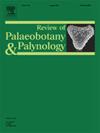梵净山国家级自然保护区九龙池湿地晚全新世花粉图谱
IF 1.7
3区 地球科学
Q2 PALEONTOLOGY
引用次数: 0
摘要
本文对樊景山国家级自然保护区九龙池湿地晚全新世花粉图谱进行了研究,为第四纪花粉鉴定和古生态解释提供了依据。花粉图谱按孔型和雕刻模式进行整理,包括针叶树、阔叶树和灌木、山地和湿地草本植物37科64属。在光学显微镜(LM)和/或扫描电镜(SEM)下对花粉颗粒进行了高分辨率成像,并附有形态指数。大多数花粉类型可识别到属水平。基于扫描电镜下高分辨率的花粉形态特征,讨论了关键分类群花粉鉴定的分类精度,以提高孢粉学和古生态解释,包括壳子科(栎、青冈和Fagus)和松科(Tsuga、冷杉和Pinus)的关键属。值得注意的是,青冈剖面的花粉孔径和雕刻模式与冬青剖面的一些物种重叠,因此在第四纪花粉分析中强烈建议将它们划分为一个生态类群。由于花粉形态高度相似,且现代花粉资料有限,目前仍有一些花粉类型被归属于科级水平,因此期望进一步的现代花粉收集与化石花粉颗粒进行详细的比较,以提高准确的归属。最后简要介绍了提高西南地区花粉化石分类分辨率的研究前景。该研究丰富了全新世花粉图谱,为研究区及邻区第四纪花粉分析提供了解释依据。本文章由计算机程序翻译,如有差异,请以英文原文为准。
Late Holocene pollen atlas of the Jiulongchi Wetland in the Fanjingshan National Nature Reserve, southwestern China
A late Holocene pollen atlas of the Jiulongchi Wetland in the Fanjingshan National Nature Reserve (a UNESCO World Heritage Site), southwestern China, is presented to facilitate Quaternary pollen identification and palaeoecological interpretation. The pollen atlas is organized according to aperture types and sculpture patterns, covering 64 genera and 37 families from conifers, broad-leaved trees and shrubs, upland and wetland herbs. The pollen grains are illustrated with high resolution images under light microscope (LM) and/or scanning electron microscope (SEM), along with a morphological index. Most pollen types are identifiable to genus level. Taxonomic precision of pollen identification for key taxa to improve palynological and palaeoecological interpretation is discussed based on high resolution pollen morphological characteristics under SEM, including key genera of Fagaceae (Quercus, Cyclobalanopsis, and Fagus) and Pinaceae (Tsuga, Abies and Pinus). Noticeably, pollen aperture and sculpture pattern of the section Cyclobalanopsis and some species from the section Ilex overlap, thus classifying them in one ecological group is highly recommended in Quaternary pollen analysis. There are still some pollen types assigned to family level currently due to high similarity of morphology and limited modern pollen references available, therefore further modern pollen collection is highly expected for detailed comparison with fossil pollen grains to improve accurate assignments. The perspectives of improving taxonomic resolution of fossil pollen identifications in the southwestern China are also briefly noted. This study enriches Holocene pollen atlas and provides interpretation aid to Quaternary pollen analysis for the study area in southwestern China and adjacent regions.
求助全文
通过发布文献求助,成功后即可免费获取论文全文。
去求助
来源期刊
CiteScore
3.50
自引率
21.10%
发文量
149
审稿时长
6 months
期刊介绍:
The Review of Palaeobotany and Palynology is an international journal for articles in all fields of palaeobotany and palynology dealing with all groups, ranging from marine palynomorphs to higher land plants. Original contributions and comprehensive review papers should appeal to an international audience. Typical topics include but are not restricted to systematics, evolution, palaeobiology, palaeoecology, biostratigraphy, biochronology, palaeoclimatology, paleogeography, taphonomy, palaeoenvironmental reconstructions, vegetation history, and practical applications of palaeobotany and palynology, e.g. in coal and petroleum geology and archaeology. The journal especially encourages the publication of articles in which palaeobotany and palynology are applied for solving fundamental geological and biological problems as well as innovative and interdisciplinary approaches.

 求助内容:
求助内容: 应助结果提醒方式:
应助结果提醒方式:


